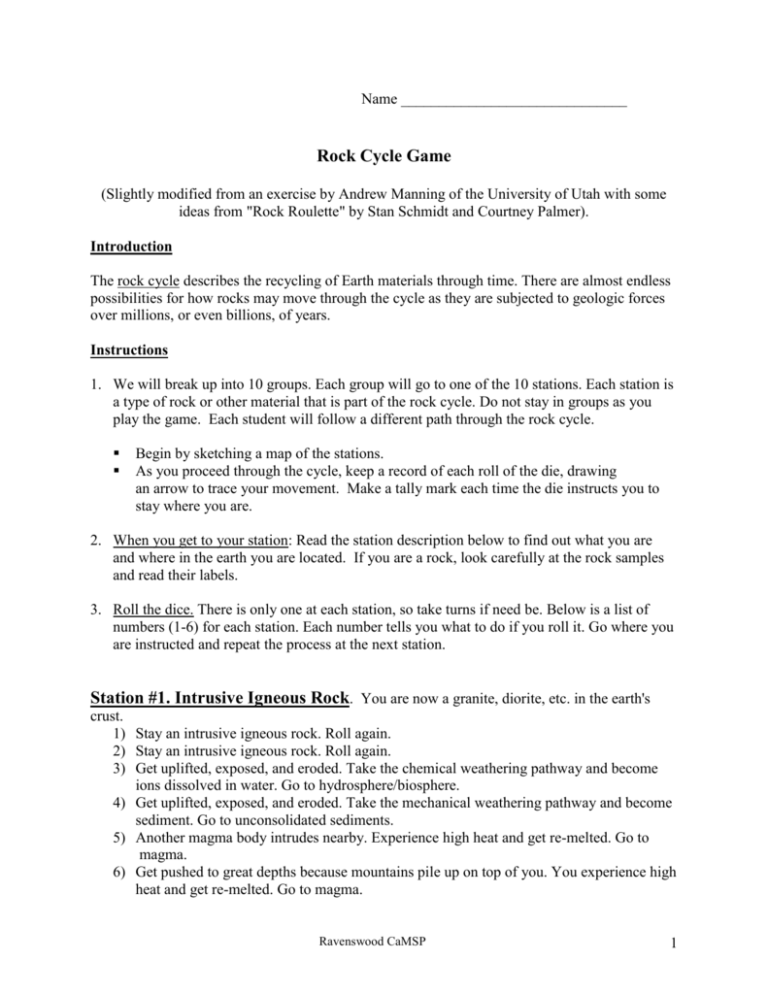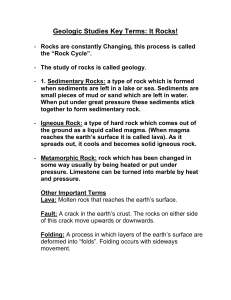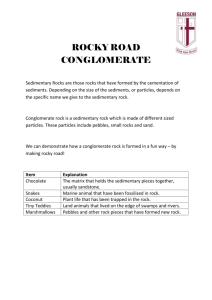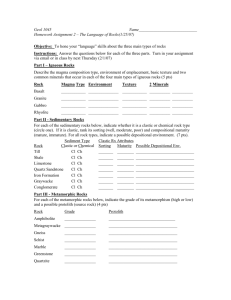Rock Cycle Game: A Hands-On Earth Science Activity
advertisement

Name ______________________________ Rock Cycle Game (Slightly modified from an exercise by Andrew Manning of the University of Utah with some ideas from "Rock Roulette" by Stan Schmidt and Courtney Palmer). Introduction The rock cycle describes the recycling of Earth materials through time. There are almost endless possibilities for how rocks may move through the cycle as they are subjected to geologic forces over millions, or even billions, of years. Instructions 1. We will break up into 10 groups. Each group will go to one of the 10 stations. Each station is a type of rock or other material that is part of the rock cycle. Do not stay in groups as you play the game. Each student will follow a different path through the rock cycle. Begin by sketching a map of the stations. As you proceed through the cycle, keep a record of each roll of the die, drawing an arrow to trace your movement. Make a tally mark each time the die instructs you to stay where you are. 2. When you get to your station: Read the station description below to find out what you are and where in the earth you are located. If you are a rock, look carefully at the rock samples and read their labels. 3. Roll the dice. There is only one at each station, so take turns if need be. Below is a list of numbers (1-6) for each station. Each number tells you what to do if you roll it. Go where you are instructed and repeat the process at the next station. Station #1. Intrusive Igneous Rock. You are now a granite, diorite, etc. in the earth's crust. 1) Stay an intrusive igneous rock. Roll again. 2) Stay an intrusive igneous rock. Roll again. 3) Get uplifted, exposed, and eroded. Take the chemical weathering pathway and become ions dissolved in water. Go to hydrosphere/biosphere. 4) Get uplifted, exposed, and eroded. Take the mechanical weathering pathway and become sediment. Go to unconsolidated sediments. 5) Another magma body intrudes nearby. Experience high heat and get re-melted. Go to magma. 6) Get pushed to great depths because mountains pile up on top of you. You experience high heat and get re-melted. Go to magma. Ravenswood CaMSP 1 Station #2. Volcanic Rock. You are now a basalt, rhyolite, etc. on the earth's surface. 1) Stay a volcanic rock. Roll again. 2) Stay a volcanic rock. Roll again. 3) Get eroded. Take the chemical weathering pathway and become ions dissolved in water. Go to hydrosphere/biosphere. 4) Get eroded. Take the mechanical weathering pathway and become sediment. Go to unconsolidated sediments. 5) Get buried deeply by sediments. Another magma body intrudes nearby. Experience high heat and get re-melted. Go to magma. 6) Get buried deeply by sediments and get pushed to great depths as mountains pile up on top of you. You experience high heat and get re-melted. Go to magma. Station #3. Clastic Sedimentary Rock. You are now a sandstone, conglomerate, etc. in the upper part of the Earth's crust. 1) Stay a clastic sedimentary rock. Roll again. 2) Get uplifted, exposed, and eroded. Take the chemical weathering pathway and become ions dissolved in water. Go to hydrosphere/biosphere. 3) Get uplifted, exposed, and eroded. Take the mechanical weathering pathway and become sediment. Go to unconsolidated sediments. 4) A magma body intrudes nearby. Experience high heat and pressure get metamorphosed. Go to metamorphic rock. 5) A magma body intrudes nearby. Experience extreme heat, melt, and get incorporated into the magma. Go to magma. 6) Get pushed to great depths because mountains pile up on top of you. You experience high heat and pressure and get metamorphosed. Go to metamorphic rock. Station #4. Metamorphic Rock. You are now a gneiss, schist, etc. deep in the earth's crust. 1) 2) 3) 4) Stay a metamorphic rock. Roll again. Stay a metamorphic rock. Roll again. Stay a metamorphic rock. Roll again. Get uplifted, exposed, and eroded. Take the chemical weathering pathway and become ions dissolved in water. Go to hydrosphere/biosphere. 5) Get uplifted, exposed, and eroded. Take the mechanical weathering pathway and become sediment. Go to unconsolidated sediments. 6) A magma body intrudes nearby. Experience extreme heat, melt, and get incorporated into the magma. Go to magma. Ravenswood CaMSP 2 Station #5. Unconsolidated Sediments. You are now silt, sand, clay, etc. at the earth's surface. 1) Stay unconsolidated sediments. Roll again. 2) Stay unconsolidated sediments. Roll again. 3) Stay unconsolidated sediments. Roll again. 4) Get buried deeply by other sediments. Undergo compaction and cementation and become clastic sedimentary rocks. Go to clastic sedimentary rocks. 5) Get buried deeply by other sediments. Undergo compaction and cementation and become clastic sedimentary rocks. Go to clastic sedimentary rocks. 6) Get buried deeply by other sediments. Undergo compaction and cementation and become clastic sedimentary rocks. Go to clastic sedimentary rocks. Station #6. Magma. You are now magma in the earth's crust. 1) Stay magma. Roll again. 2) Stay magma. Roll again. 3) Crystallize in the crust and become an intrusive igneous rock. Go to intrusive igneous rock. 4) Crystallize in the crust and become an intrusive igneous rock. Go to intrusive igneous rock 5) Get erupted and crystallize on the earth's surface. Go to volcanic rock. 6) Get erupted and crystallize on the earth's surface. Go to volcanic rock. Station #7. Nonclastic (Chemical) Sedimentary Rock. You are now a limestone, evaporite, etc. near the earth's surface. 1) Stay a nonclastic sedimentary rock. Roll again. 2) Get uplifted, exposed, and eroded. Take the chemical weathering pathway and become ions dissolved in water. Go to hydrosphere/biosphere. 3) Get uplifted, exposed, and eroded. Take the mechanical weathering pathway and become sediment. Go to unconsolidated sediments. 4) Get buried under other sedimentary rocks. A magma body intrudes nearby. Experience high heat and pressure get metamorphosed. Go to metamorphic rock. 5) Get buried under other sedimentary rocks. A magma body intrudes nearby. Experience extreme heat, melt, and get incorporated into the magma. Go to magma. 6) Get pushed to great depths because mountains pile up on top of you. You experience high heat and pressure and get metamorphosed. Go to metamorphic rock. Ravenswood CaMSP 3 Station #8. Mantle Rock. You are a peridotite, eclogite, etc. in the earth's upper mantle. 1) 2) 3) 4) 5) 6) Stay mantle rocks. Roll again. Stay mantle rocks. Roll again. Stay mantle rocks. Roll again. Stay mantle rocks. Roll again. Stay mantle rocks. Roll again. Get partially melted and become magma. Rise at mid-ocean ridge and cool to form oceanic crust. Go to oceanic crust. Station #9. Oceanic Crust. You are now basalt or gabbro in the oceanic crust drifting away from a mid-ocean ridge. 1) Stay oceanic crust. Roll again. 2) Get subducted and re-assimilated into upper mantle. Go to mantle rocks. 3) Get subducted and re-assimilated into upper mantle. Go to mantle rocks. 4) Get subducted and re-assimilated into upper mantle. Go to mantle rocks. 5) Get subducted, experience extreme heat, and melt. Become magma that rises upward. Go to magma. 6) Get subducted, experience extreme heat, and melt. Become magma that rises upward. Go to magma. Station #10. Hydrosphere/Biosphere. You are now dissolved ions in an ocean, river, plant, animal, etc. 1) Stay in the hydrosphere/biosphere. Roll again. 2) Stay in the hydrosphere/biosphere. Roll again. 3) Get utilized by marine organisms and precipitate in the form of shells, coral, or other "hard part". Accumulate on the ocean floor and become limestone. Go to nonclastic sedimentary rock. 4) Get utilized by marine organisms and precipitate in the form of shells, coral, or other "hard part". Accumulate on the ocean floor and become limestone. Go to nonclastic sedimentary rock. 5) Precipitate in a saline lake or restricted by in a desert climate and become evaporite. Go to nonclastic sedimentary rock. 6) Precipitate at a hot spring and become tufa. Go to nonclastic sedimentary rock. Questions 1. Where did you spend the most time? 2. Why did everyone not follow the same path? Ravenswood CaMSP 4 References Manning, Andrew, Rocks and the Rocks Cycle (Demonstration #2), http://www.cc.utah.edu/~ahm2/teaching.html Smith, Stan M. and Palmer, Courtney, 2000, Rock Cycle Roulette: The Science Teacher, November 2000, p. 34-37. Ravenswood CaMSP 5








